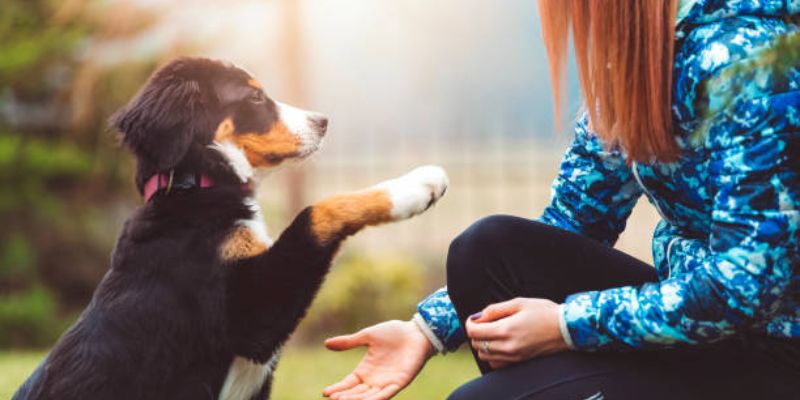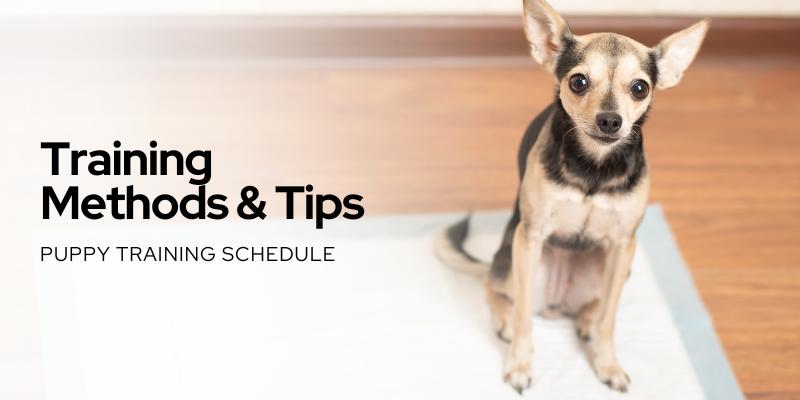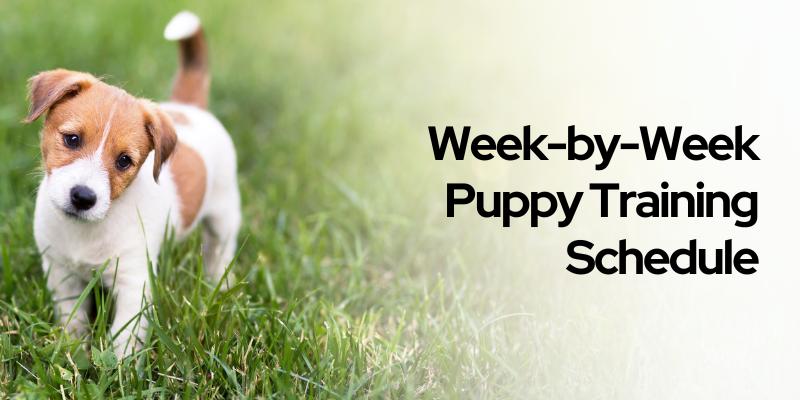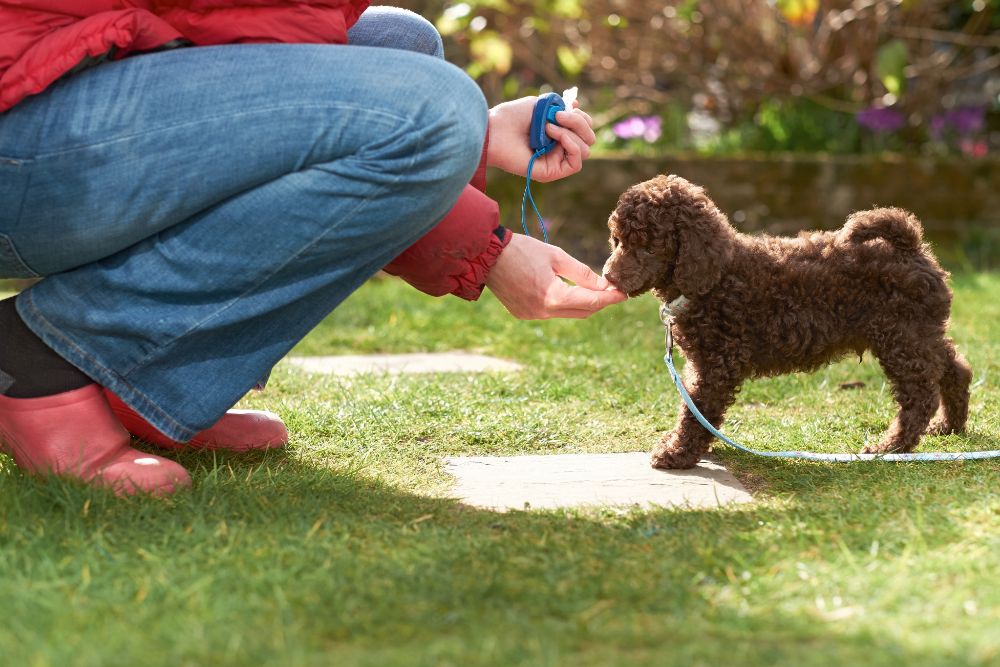Puppies are adorable bundles of joy AND incredible handfuls. Between the bursts of energy, constant chewing, and endless potty breaks, it is easy for new puppy parents to become overwhelmed by and exhausted. Creating a daily routine and puppy training schedule will change your life and your puppy’s life for the better.
We’ll give you a full run-down of what your week-to-week puppy training schedule should look like, including:
When you bring a young puppy home, their cute little face and droopy ears win your heart immediately. But as much as you love them, you might seriously question whether you can handle having a puppy!
Even when they’re a ‘good’ puppy, the demands of raising a puppy are high. You’re constantly exhausted. Between the early morning pee breaks, the constant need for attention, and misbehavior, you will be tired.
Meanwhile, your job requires a level of focus, and your puppy may not allow that. You may feel as if you’re approaching a breaking point, and that’s when you need to create a training schedule and daily routine (we obviously suggest you create this before you hit the breaking point!).
If you’ve gotten to this point, you may feel desperate and finally give training a go. If approached effectively, sometimes it might only take a few days to start seeing a change in the pup’s behavior. For one of our writers, it only took a few days of consistency for their puppy to recognize the patterns and start following their lead!
Before introducing a training schedule, their pup was always restless and bored. Why? Because their puppy’s life had no structure, so naturally a puppy will fill it, however they want to. The schedule and routine take the guesswork out of a puppy’s daily life.
It gives them structure and support. It will help your puppy learn the rules of the house and feel more confident. And, equally importantly, it will help you feel less stressed as a new puppy parent!
Our message? Start a training schedule and daily routine early, so that by 6 months old you can be comfortably living your routine, with your puppy’s training progressing naturally.
A puppy training schedule consists of two main elements:

A daily routine designed to pair with your own.
It should consist of consistent feeding times, potty breaks, and play times that fit with your schedule. As your fur baby grows, the frequency of each event will reduce, but let your pup guide that process.
At around the 5–6-month mark, you might notice that your puppy only needs to go outside to pee every 3-4 hours, as opposed to almost every 1-2 hours. So, you can remove a couple of the afternoon breaks and transition to a morning, noon, and evening potty break schedule.
Tip: Use your routine to create cues for them by connecting an event with an action. For example, the first thing you do when you wake up is take them out to go potty. Do this consistently, and they will learn to control their bladder until you wake up.
Another example is giving them a chew bone every time you sit down to work at home. Eventually, they will come to learn that when you are at your desk that is their time to chew and then nap.
A progressive training schedule that helps you and your pup develop over time.
Training is a marathon, not a sprint, and every dog learns at a different rate. With some dogs, you’ll be lucky if they learn to sit and heal. With others, you can give them a wide array of commands, and they will soak them up like a sponge.
What to consider when creating your puppy training schedule:
- Your pup’s needs: Are they differently abled? What do they need to learn to remain happy, healthy, and safe?
- Your pup’s age: They are babies, and their needs and capabilities change as they grow.
- Your schedule and capabilities: They are part of your life, so figure out how to work their schedule into yours and vice versa.
- Your training methods: There are plenty of training methods out there. Choose the ones that work best for you and your puppy. We rally behind the positive reinforcement approach.
Training Methods and Tips

There are a lot of training methods out there, but here are a few of our favorite strategies and tips.
Management:
A key method of training that involves controlling the situation and environment around your puppy in an effort to help them avoid getting into trouble. For instance, making sure they have easy access to a pee-friendly space during the early stages of potty training.
Examples:
- Crate training to keep them safe and help them contain their energy when guests are over.
- Using a baby gate or pen to restrict their access to parts of the house.
- Using a harness and lead to prevent them from jumping on people.
Positive reinforcement:
You can’t expect your puppy to know right from wrong without first teaching it to them. So, it doesn’t make sense to punish them for something they didn’t know was wrong.
Since you don’t speak the same language, it will take time and consistent behavior for them to connect an action or inaction to a result.
Rather than training your pup through punishment, we suggest a reward system based on your puppy’s motivators. Use treats if they are food-driven or affection if they are love driven.
Reward them when they behave correctly and refuse reward when they don’t.
Patience and Consistency:
Dogs don’t speak our language. The best way to communicate with them is through your actions. They are constantly watching you.
You need to remain consistent if you want them to understand what you are “saying.” And it will take time, so be patient.
PRACTICE!:
“Practice makes perfect.” It’s an overused phrase, but that doesn’t make it any less accurate. It is true for sports, and it is true for dog training.
Unlike training for a marathon or sports team, dog training only requires a few minutes of practice daily for it to be effective.
A Breakdown: Puppy Training Schedule Week-by-Week

What are the various age categories for puppy training?
Ages 8-10 Weeks
- Introduce a daily schedule that includes feeding times, play times, potty breaks, and naptimes.
- Potty Training
- Crate training
- Redirect chewing and mouthing
- Name recognition
- Commands: Sit and come
- Socialization: family, close friends – people who frequent your home.
- Establish that the house is a quiet and safe space.
This stage is all about getting them acclimated and setting expectations. They don’t know the rules yet, so take your time and be patient. If they are behaving poorly, redirect them. If that doesn’t work, refuse reward until they act correctly.
At this point, the training schedule and daily routine will involve a lot of small actions. Take them to go potty every 1-2 hours and play with them for 10 minutes 5-6 times a day. Use their dog crate or puppy pen to help manage their zoomies.
Potty Training Tip: Puppies will be able to smell trace amounts of their old urine. If you are struggling to get them to use a pee pad, place the pad over one of their old pee spots. They will instinctually return to that spot when they need to go potty again.
Ages 10-12 Weeks
- Introduce leash and harness
- Doorway thresholds: teach your pup to wait at doorways
- Impulse control: food and water
- Obedience training through simple commands and consistent rewards
- Commands: place, down, and heel
- Socialization: common noises
By this point, they will be acclimated enough that you can start to introduce basic obedience commands and practice impulse control.
They won’t have a long attention span, so keep your puppy training sessions to around 10 minutes, but try doing multiple sessions a day. Start with commands like sit, down, and wait. These commands are foundational and can be used at later stages of the training process.
If you want them to be comfortable around people, it’s vital that you keep socializing with them as well. Remember that whatever behavior you allow now, they will continue as they get older.
Ages 3-4 Months
- Structured play: tug of war and fetch
- Heel practice in your yard
- Command combinations indoors
- Hold commands for longer
- Commands: stay and drop it
- Socialization: to new dogs as long as they are vaccinated
You can start increasing the duration and complexities of your commands. Hold commands longer, combine commands to prolong reward, and feel free to introduce a few new commands.
You can practice heel and introduce stay and leave commands. They will have longer attention spans now, so you can also introduce more structured play times, including fetch or tug of war.
Ages 4-6 Months
- Heel practice around the neighborhood
- Advance commands outside and in new locations
- Add distance, distractions, and duration (the 3Ds)
- Begin to wean off food rewards
Your fur baby is now old enough to start working on their commands outside of the house. The world is full of noise and distractions, so it might feel like they are regressing, but they aren’t. Be patient and maintain consistent expectations; they will learn to ignore the noise and listen to you.
This is also an excellent time to start weaning them off food rewards if you haven’t already.
Ages 6-12 Months
- Adjust your daily schedule as needed, and then maintain consistency
- Increase training commands, walks, and regular socialization
- Advance commands outside with a long-line lead training
- Increase the 3Ds, and work in new locations.
Now it is all maintenance and reinforcement. They know the rules. They know what is expected of them. Continue increasing the 3Ds; distance, distraction, and duration.
If your puppy loves learning and is up for a challenge, you can start introducing fun commands and tricks, but it’s unnecessary.
Your Puppy Training Schedule Week-by-Week
There is no one way to train a puppy. Every dog is different, and they learn at varying speeds. This puppy training schedule is a great guide, a starting point around which you can tailor the routine to fit your life and your dog.
We’ve put together a printable puppy training schedule week-by-week for you to use to create your own customized schedule that fits you and your puppy’s daily routine and preferences.
Remember to stay consistent and ensure your fur baby feels safe and loved throughout the process.








